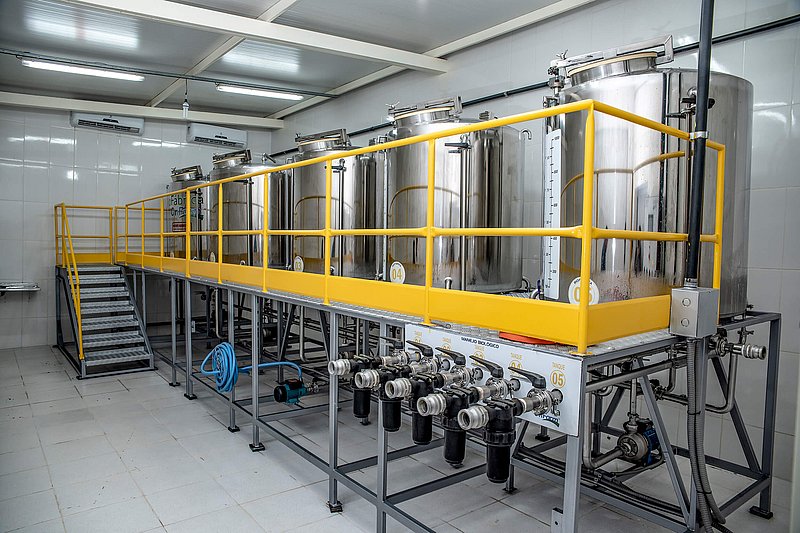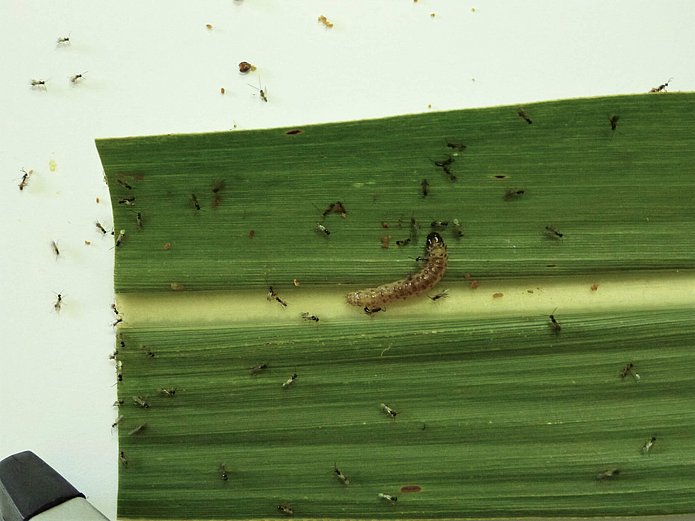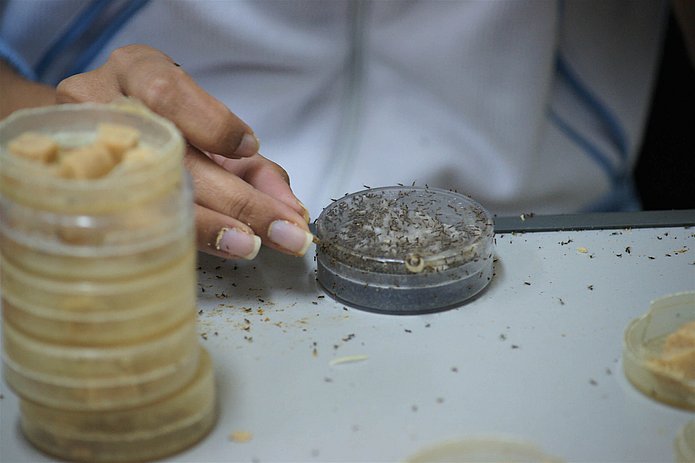Help from nature
by Evaristo de Miranda
In only a few countries of the world beneficial organisms play such an important role as in Brazil. Hundreds of species of bacteria, protozoans, fungi, mycorrhizae, acarids, insects and their pheromones are identified and then propagated. They are produced in laboratories, bioengineering companies and in agricultural farms. The objectives mainly are to increase productivity by means of symbiotic nitrogen fertilisation, to contribute to the biological activity of the soil and to fight pests as well as diseases biologically.

Beneficial organisms and biological auxiliaries are used on the most different types of arable land: on large and small farms, from the equator to the more temperate zones of Brazil. Sales are increasing year by year. This is also true for the application technology, from transport logistics via spraying technology to drones and planes that are used for agricultural purposes. Start-ups, national and international companies are bustling in this market.
Production, sales and application are controlled by laws. They govern the production and the sales of fertilisers, regulators, inoculants, biofertilisers, remineralisations and substrata for plants that are intended for agricultural use. The law that applies is 12.890/ 2013.
The main fields of application for beneficial organisms and biological auxiliaries are:
- Biological nitrogen fertilisation
In Brazil, biological nitrogen fixation via rhizobia is very important for the nutrient supply of useful plants. They cover the nitrogen requirement of a lot of pulses (beans, soybeans and peanuts) rendering a nitrogen fertilisation completely redundant. To produce one ton of soybeans, about 80 kg of nitrogen are required that are completely absorbed due to the connection of the plant roots with the nitrogen-fixing bacteria.
Several selected strains of bacteria are used on about 35 million hectares of arable land. The treatment of the seed with at least 160,000 bacteria per grains results in an annual nitrogen fertiliser saving of 8.5 billion US Dollar. The biological nitrogen fixation is adapted to the requirement of the crop. This technology, thus, minimises environmental problems that normally come along with mineral nitrogen fertilisers, like the entry into the groundwater, the eutrophication of lakes, the emission of nitrous oxide etc.
Brazilian research institutes and private companies have developed highly efficient strains of bacteria of the genera rhizobium and brady rhizobium as well as for example azospirillum brasilense. These new bacteria increase the nitrogen fixation in the rhizosphere of wheat, maize and pastures. Moreover, they produce phytohormones that stimulate root growth. This increases the water absorption and nutrient uptake area and strengthens the drought resistance of the plants. Tests carried out by Vogel et al. (2015) as well as by Stets (2013) and Roesch et al. (2005) actually showed positive effects of azospirillum brasilense with regard to the root and leaf growth for wheat. Altogether the different available biological auxiliaries result in savings amounting to approximately 15 billion US Dollar per year for the Brazilian farmers

- Structural auxiliaries
The objective is to maximise biological variety in the soil, increase fertility and create a soil structure that is favourable for the development of roots and plants – even without a plough and for no-till farming. Based on molecular genomic this biotechnology is used like a probiotic in Brazil and stimulates the biological variety in the soil microbiome.
Farmers produce the crop media on their own farms. The application rate amounts to 150 litres per hectare and they can be applied together with a herbicide. Part of the costs for microbiological fertilisation can be compensated for by fuel savings as no tillage or deep loosening measures are carried out. Most of the costs for microbiological fertilisation incur for refilling the bioreactors for production.
In this case, it is not about fertilisers or organic matter, but about microbiological auxiliaries that are suitable for any type of soil. The technology adapts to the regional conditions and reacts to the so-called “biological fingerprint“ of every crop. It is sort of a microbiological fertiliser that is custom-tailored to the respective agricultural area. The production process can be adapted to any farm size as well as to any type of crop.
Due to the multifunctionality in the production system the focus of microbiological fertilisation is on the re-establishment of biological variety in the soil, especially of bacteria. Molecular analyses show the existence of up to 500 different groups of bacteria in a well carried out fermentation. This includes groups that produce a bacteria gel (polyureic acid) that is able to aggregate soil particles. The gel creates soil structure, builds up soil crumbles and supplies the soil with more oxygen and water. This has a positive effect on fertility.
Moreover, this microbiological fertilisation extends the connection of the soil with the plant by exudation. Most of the energy (an average of 30 %) that is generated by photosynthesis is used for exudation. In one cultivation year maize releases about one million litres of polysaccharides per hectare (or 10 t of dry organic matter per hectare). These exudates feed the microbiota around the roots. They are of advantage to the plant, e.g. they increase the availability of minerals that are responsible for the resistance to diseases. Studies showed increases in productivity even in regions with nematodes.
- Biological plant protection
This is the general term for micro- and macrobiological agents to fight pests and diseases. They are produced by companies who have specialised in the identification and propagation of fungi, bacteria, acarids and insects who are to be used for crops in integrated plant protection. Hundreds of companies have been founded in this sector. It already makes up for just under 25 % of the plant protection market in Brazil.
The guideline for the production of biological auxiliaries is the development of new products, types of applications and the better adaption of existing organisms to the different climate zones in Brazil. Besides the commercial companies several public research institutes deal with the development of new technologies. Due to the tropical climate in the country there is a demand for different biological agents as there is a health pressure on the crops the whole year round.
Numerous parasitoids, pathogenic agents, pests and antagonists are used in programs for biological control for products (soya, maize, cotton and coffee) in small gardens and orchards in all regions in Brazil. Most of the biological agents fight pests and diseases which are among others caused by caterpillars, whiteflies, gall nematodes, root leaf cicadas, cane borers, phytophagic acarids and fungus gnat flies, encluding soil-borne pathogenic agents and pests.
The most frequent biological plant protection agents are insecticides, fungicides and nematicides. The most important biological agents are: Bacillus thuringiensis, Trichogramma pretiosum, Beauveria bassiana, Trichoderma spp., Bacillus spp., Bacillus pumilus, Metarhizium anisopliae, Cotesia flavipes, Trichogramma galloi and Raubmilben.
Bacillus pumilus for example has a fungicidal effect which protects the plant from the development of pathogenic agents on the surface of the leaf and in addition activates the immune system of the plant. It is used for soya, onions, apples and strawberries and shows its effects when fighting fungal diseases like mildew, botrytis, violet spot and Asian rust.
Beauveria bassiana is a natural growing fungus that causes lethal diseases in some insects. If it is applied to the leaves, it takes an effect when fighting cicadas (Dalbulus maidis), whiteflies (Bemisia tabaci), termites and ants as well as some caterpillars (Brassolis sophorae). This biological insecticide is frequently used when growing sugarcane, maize, rice, cotton and beans.
The most important crops these methods are used for in Brazil are soya (Bt) as well as sugarcane (Metarhizium and Cotesia). Among others, the most frequently used application methods are: leaf spraying, the release of pupae and adult beneficial organisms, seed treatment, inoculation of the soil into the furrow while sowing as well as the use of drones when spreading parasitic wasps and fungi.
Pests are also fought with biological traps that are produced by companies with comprehensive experiences in this sector. The traps are not only based on pheromones, but also on sound attraction, colours and light. There are many strategies that differ for vegetables, flowers, cotton, coffee, citrus fruits, apples, papayas, mangos, soya, beans and cereals for storage.
Infrastructure
In Brazil, biological plant protection is quite common on small farms (horticulture, fruit growing …) as well as on large fields (cereals, cotton, sugarcane, reforestation, fruit growing). This led to an industrial production of beneficial organisms and biological auxiliaries. Many farmers built their own plants to produce them on their farm. What is special about it is that the fungi, acarids and wasps are kept alive. Unlike chemical plant protection agents, they cannot simply be kept on a shelf. To guarantee the application on millions of hectares under Brazil’s most different ecological and even socio-economic conditions, the agricultural sector had to make huge efforts.
As a result, a network of differently sized companies developed, like for example for applying living agents from the air, setting up trap plants, analysing the infestation level via automated monitoring systems.
Sound knowledge about the physiology of the plant, the biology of the pests and the pathogenic agents, the early diagnosis, the correct assessment of the severity of the pest infestation and the environmental conditions is indispensable. Very sophisticated monitoring systems that already work on the “Internet of Things“ (IOT) are required for the plant protection management. The success also depends on the prudent use of resistant or tolerant varieties, among them genetically modified organisms (GMO).
In my opinion, the widespread use of beneficial organisms and biological auxiliaries, but also the industrialisation of the necessary environment make the Brazilian agricultural sector one of the most advanced in agricultural production in general, but especially regarding the encouragement of plant health.
Read more about the practical experiences of a 600,000 ha farm in Brazil.

